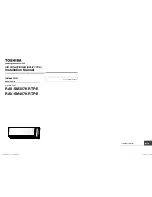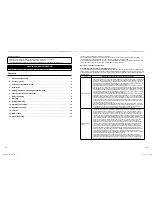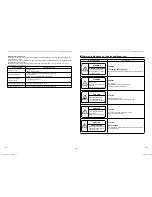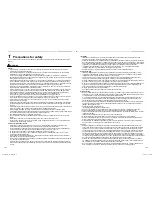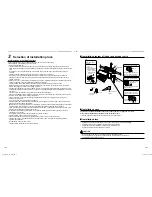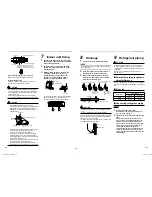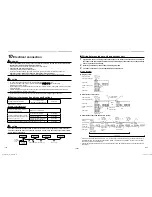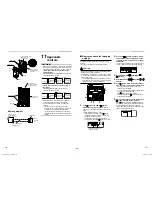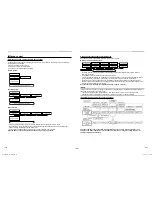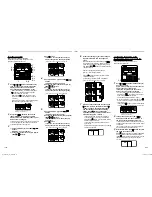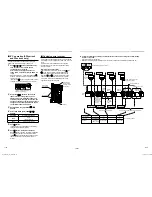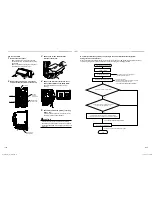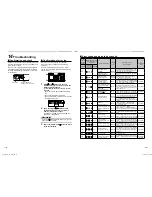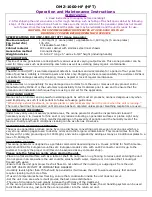
15-EN
16-EN
A
A
10
Gas side
Heat insulator provided
Indoor unit shield pipe
Cut the heat insulator of the gas pipe
(locally procured) leaving a 10 mm
overlap with the shield of the shield pipe.
Liquid side
Heat insulator wrapping cross section A-A
Make the slit part of heat insulator to upward.
▼
Insulating the pipes
Insulate the indoor unit completely so there are no
gaps using the heat insulator provided.
CAUTION
Securely apply insulation all the way up to the pipe
connecting section of the indoor unit so that there is
no exposed area. (the pipe exposed to the outside
causes water leak.)
When wrapping the heat insulator around pipes,
make sure the slit aperture toward the ceiling surface.
CAUTION
•
Bind the auxiliary pipes (two) and system
interconnection wire and control wiring with facing
tape tightly. In case of leftward piping and rear
leftward piping, bind the auxiliary pipes (two) only
with facing tape.
System interconnection wire
Indoor unit
Auxiliary
pipes
Installation plate
Wired remote controller
wiring
•
Carefully arrange pipes so that any pipe does not
stick out of the rear plate of the indoor unit.
•
Carefully connect the auxiliary pipes and
connecting pipes to one another and cut off the
insulating tape wound on the connecting pipe to
avoid double-taping at the joint, moreover, seal the
joint with the vinyl tape, etc.
•
Since dew results in a machine trouble, make sure
to insulate both the connecting pipes.
(Use polyethylene foam as insulating material.)
•
When bending a pipe, carefully do it, not to crush it.
7
Indoor
unit
fi
1
Pass the pipe through the hole in the wall,
and hook the indoor unit on the installation
plate at the upper hooks.
2
Swing the indoor unit to right and left to
con
fi
rm that it is
fi
rmly hooked up on the
installation plate.
3
While pressing the indoor unit onto the
wall, hook it at the lower part on the
installation plate. Pull the indoor unit
toward you to con
fi
rm that it is
fi
rmly
hooked up on the installation plate.
1
2
Hook here
Installation plate
Press
(unhook)
Hook
For detaching the indoor unit from the installation
plate, pull the indoor unit toward you while
pushing its bottom up at the speci
fi
ed parts.
Push
Push
– 8 –
8
Drainage
1
Run the drain hose sloped downwards.
NOTE
Hole should be made at a slight downward slant on
the outdoor side.
2
Put water in the drain pan and make sure
that the water is drained out of doors.
3
When connecting extension drain hose,
insulate the connecting part of extension
drain hose with shield pipe.
Do not form the drain hose
into a wavy shape.
Inside the
room
Do not put the
drain hose end
in the drainage
ditch.
Do not put the
drain hose end
into water.
Do not rise the drain hose.
Shield pipe
Extension drain hose
Drain hose
50 mm
or more
CAUTION
Arrange the drain pipe for proper drainage from the
unit.
Improper drainage can result in dew-dropping.
This air conditioner has the structure designed to drain
water collected from dew, which forms on the back of
the indoor unit, to the drain pan.
Therefore, do not store the power cord and other parts
at a height above the drain guide.
Space for pipes
Wall
Drain guide
9
Refrigerant
piping
CAUTION
When the refrigerant pipe is long, provide support
brackets at intervals of 2.5 m to 3 m to clamp the
refrigerant pipe. Otherwise, abnormal sound may be
generated.
Use the
fl
are nut attached with the indoor unit or
R410A
fl
are nut.
■
Permissible piping length and
height difference
They vary depending on the outdoor unit. For details,
refer to the Installation Manual attached to the outdoor
unit.
■
Pipe size
Model: RAV-
Pipe size (mm)
Gas side
Liquid side
SM30
Ø9.52
Ø6.35
SM40
Ø12.70
Ø6.35
■
Connecting refrigerant piping
Flaring
1
Cut the pipe with a pipe cutter.
Remove burrs completely. (remaining burrs
may cause gas leakage.)
2
Insert
a
fl
are nut into the pipe, and
fl
are the
pipe.
Use the
fl
are nut provided with the unit or
the one used for the R410A refrigerant. The
fl
aring dimensions for R410A are different
from the ones used for the conventional R22
refrigerant. A new
fl
are tool manufactured
for use with the R410A refrigerant is
recommended, but the conventional tool can
still be used if the projection margin of the
copper pipe is adjusted to be as shown in the
following table.
1111056499_(01)_EN.indb 8
1111056499_(01)_EN.indb 8
10/13/14 9:13 AM
10/13/14 9:13 AM

